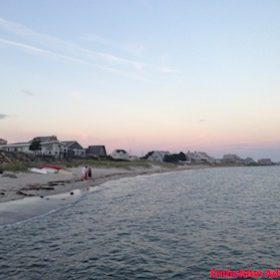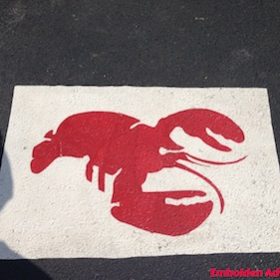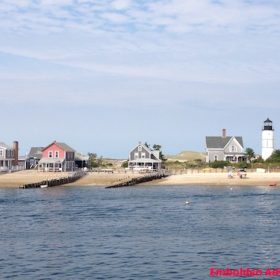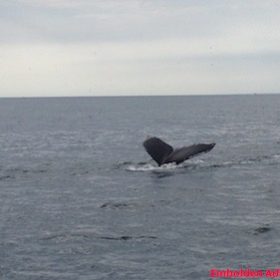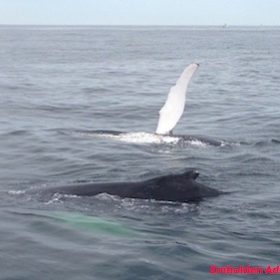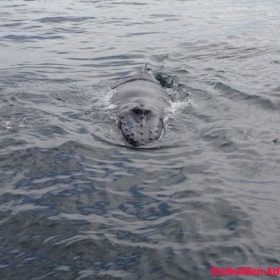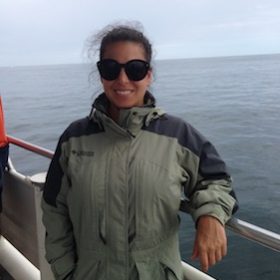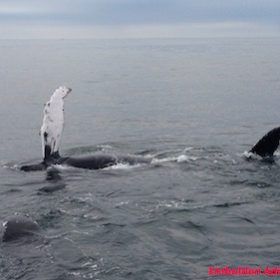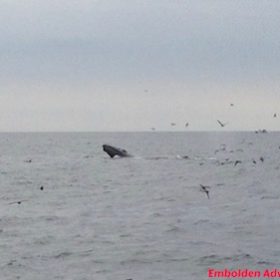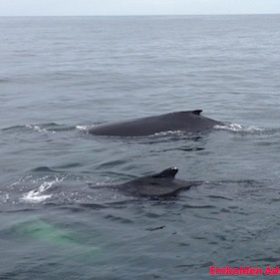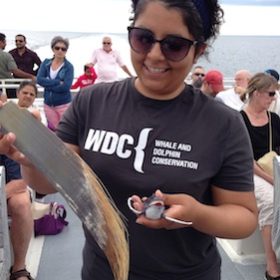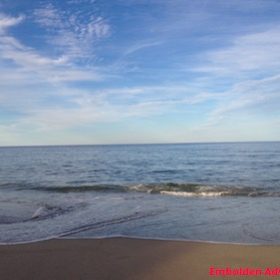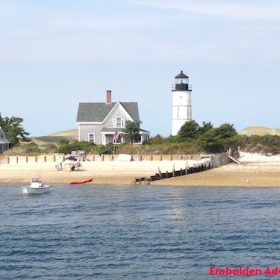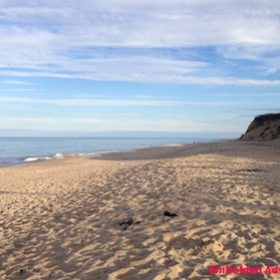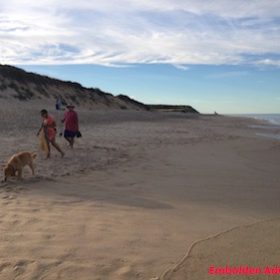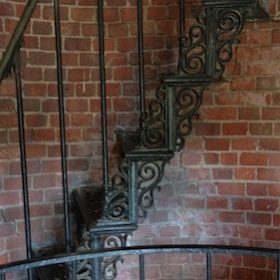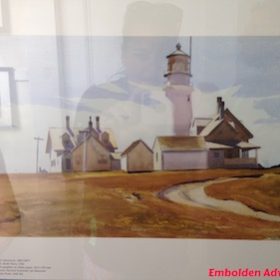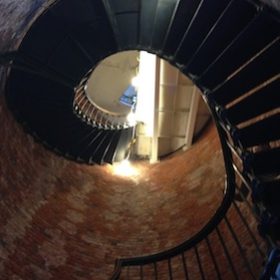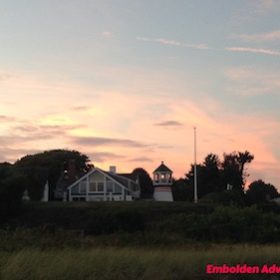Come enjoy a whale of an adventure in Cape Cod while experiencing quintessential New England such as:
- Exploring Classic New England Sea Towns
- Up Close with the Humpback Whales
- Welcoming the Great White Sharks
- Seeing the Sand Dunes of Cape Cod National Seashore.
- Why Broadway and US$10 Bill Star Alexander Hamilton Cared About Lighthouses
- Dining on Lobster in Provincetown
- …and more!
New England is known for its gorgeous ombre of reds, oranges, and yellow foliage during the autumn months. Check out a classic American road trip adventure around western Connecticut, exploring rural New England just in time for the colorful fall leaves to change.
Also, New England is known for its vintage seashores, reminiscent of its fishing, whaling, and seafaring past. Old homes made of clapboard, shingle, and stone still stand the tests of time and weather. One familiar New England area in particular is Cape Cod and the nearby islands of Nantucket and Martha’s Vineyard.
Cape Cod, New England
Cape Cod is a stretch of land and seashore off the southeast coast of mainland Massachusetts.
It is a popular vacation destination that embodies iconic New England with charming cedar grey and brown clapboard homes decorating its shoreline.
Cape Cod is shaped like the arm of a body builder flexing his muscle. Its “bicep” forms the Upper- and Mid-Cape areas, its “elbow” forms the Lower-Cape area, and its “forearm” forms the Outer Cape area. Provincetown, a New England summer sea town, is located at the northern curl of the cape or the “fist” of the arm.
Typically people drive into the Cape over one of the two bridges spanning Cape Cod Canal, but also the Cape is accessible by train, plane, and ferry.
The towns of Bourne, Sandwich, Mashpee, and Falmouth form the western part of the Cape, known as the Upper-Cape, and are closest to the mainland.
Hyannis, made famous by the Kennedy family and their massive family compound, is part of the Mid-Cape. This area also includes the towns of Barnstable, Yarmouth, and Dennis. High-speed ferries to Martha’s Vineyard or Nantucket Island depart from Hyannis.
The downtown area of Hyannis has the marina and a few chowder and lobster houses. Along its main stretch, walk the sidewalks, pop into a few souvenir shops, and grab a cone of homemade ice cream.
Whale Watching
Whale watching is a popular activity during the summer months in the Cape.
In fact, whale watching in Cape Cod is considered to be one of the Top Ten Whale Watching spots in the world by World Wildlife Fund.
The whales can be spotted any time from April through October, at a near guaranteed rate. They start appearing as early as mid-March and hang around as late as the beginning of November before leaving for the winter season.
One of my most favorite ocean travel memories is going on a scuba dive in Hawaii at 5:30 in the morning. It was the first time I went scuba diving at dawn. As the sun was rising and brightening up the underwater world, we began to hear the humpback whales squeal as if they were roosters welcoming the start of the morning.
While I have never seen a whale while scuba diving, hearing these whales was a spellbinding, magical moment for me. I was awestruck and felt surrounded by pure beauty of the humpback whales. The animals of the ocean have this gorgeous spirit energy that can be positively life changing to any person.
The humpback whales come to Cape Cod from the Dominican Republic in their migration north along the eastern coast of the United States. Humpback whales are known to migrate 16,000 miles a year.
From approximately December to April, these whales congregate in an area called Silver Bank located 60 miles off the coast of the Dominican Republic. The Silver Bank is a humpback whale breeding area and nursery for baby whales. Scientists believe this area contains the largest population of humpback whales in the North Atlantic Ocean, if not the world, with estimates of between 3,000 and 7,000 whales in this 20 square mile area.
At the Silver Bank, the humpback whales are not feeding and start to lose their weight. Typically, a grown humpback whale weighs about 37 tons and is the length of 35 to 55 feet.
So around April, the whales head north towards the Cape Cod area to the Stellwagen Bank, located about 5 miles north of Provincetown, for a feasting bonanza.
The humpback whales at the Stellwagen Bank feed on krill and small schools of fish such as mackerel herring. Each whale consumes between 1 and 2 tons of food a day.
Biologists who study the whales in this area estimate about four dozen whales hang out in these shallow waters throughout the season.
So let’s do the math: Roughly 50 whales in the area are eating 2 tons of food a day totaling 100 tons of food per day. Over a 6-month period, or 180 days, these whales are consuming approximately 180,000 tons of food in Cape Cod waters!
The Stellwagen Bank is a shallow underwater plateau 19 miles wide by 6 miles long and under about 100 to 200 feet of water. The steep cliffs of the plateau drop down to 300 to 600 feet and trail off to the deeper Continental Shelf.
This bank is part of the larger Stellwagen National Marine Sanctuary, a US federally protected marine area the size of 842 square miles that was once a desirable area for New England fishing and whaling back in the 1700s. Humpback whales were hunted to the brink of extinction by 1966 but have made a tremendous comeback to a known population of about 80,000 right now.
This area of the ocean is rich with nutrients from upwells coming from the deeper, colder waters. This underwater phenomenon, along with strict fishing regulations and marine protections, has fostered a healthier and more balanced underwater ecosystem for species to survive and thrive. Now an estimated 130 marine species from the smallest of fish to the largest of whales can be found from one time to another here.
www.youtube.com/embed/uZR6DU-K4M0
Did you know..?
A marine national monument in the Atlantic Ocean located 130 miles southeast of Cape Cod was established recently? Called Northeast Canyons and Seamounts Marine National Monument, this area is the size of about 5,000 square miles or roughly the size of the state of Connecticut. It is known to be an “underwater Serengeti” rich with a uniquely diverse, rare, and endangered ecosystem of fish, whales, turtles, and corals. Underwater canyons, perhaps deeper than the Grand Canyon, and four underwater mountains or “seamounts” line this portion of the ocean floor. Now it will be protected from fishing, oil and gas exploration, and drilling, preserving its important ecosystem.
We took the whale watching boat, departing from Barnstable. Other whale watching tours depart from Provincetown. Our boat was the size of a large ferry filled to the max with many eager whale-watching tourists.
Bring a windbreaker coat or rain jacket with you on the boat and wear comfortable, rubber-soled shoes. In the colder months, bring a winter jacket, hat, and gloves. Be sure you have a secure hat that cannot be blown off your head by a gust of wind. Have your camera fully charged and ready to take a few action shots when the whales appear.
Our ride out to the Stellwagen Bank took about an hour or so. In passing the time, a marine biologist with extensive whale and other marine animal knowledge and a representative from the local Whale and Dolphin Conservation Group provided educational information about the whales and marine life. The marine biologist gave helpful commentary on the loud speaker throughout the tour and even pointed out some whales for us.
For example: Did you know that two types of whales exist? They are odontocetes or tooth whales, and baleen whales.
Tooth whales are whales with just that: Teeth. These whales hunt using their large, sharp teeth and powerful jaws. Sperm whales, belugas and narwhals, dolphins, orcas or better known as killer whales, and porpoises are examples of tooth whales.
Baleen whales, on the contrary, are filter feeders. They open their large mouths to gulp a copious amount of seawater filled with tiny fish, shrimp, plankton, and krill. The whale closes its mouth and the water drains out through slits between its baleen plates, trapping behind its food.
Baleen plates are long, flat, and wide keratin strips that hang down from the upper jaw of the whale. Keratin is the same hard material that forms our hair and nails. At the end of the plates are these wispy strains of keratin that look like hair but are just as hard as the plate itself. These plates are aligned parallel to one another with little space in between them. They sort of resemble a fine tooth plastic comb stretching around the “gums” of the whale.
Some types of baleen whales are the blue whale, fin whale, right whale, minke, and humpback whale.
And many of these types of whales can be seen in Cape Cod. Humpback whales are not the only show. Other whales such as the finback, minke, right, and pilot whales are common sightings too.
On the tour, our guide spotted a minke whale in the distance. The minke whale looks like a larger, streamlined and smoother whale with a small dorsal fin more closely resembling a shark fin.
Less common but also possible whale sightings in Cape Cod are of the sperm, beluga, sei, and blue whales, the largest animal ever known to exist on earth.
Sea creatures like grey seals, mola molas or the sunfish, blue sharks, mako sharks, and other types of sharks also patrol the waters. We saw the head of a grey seal pop out of the water while we were trying to spot a few whales.
Rarely do orcas swim by the area close to shore, although an orca was sighted recently this August! Scientists believe that because of warming waters, the orcas are traveling farther in search of food including fish, squid, sea turtle, and sea birds.
Our whale watching tour lasted about half the day in which we spent the time boating around the area in search of whales. In that time, we spotted about 20 to 25 whales scattered around the larger area together in groups of about two to perhaps 6 or 7 whales.
Usually the seagulls gave away the whales’ location as they hover over the water in anticipation of grabbing an errant fish during a whale feeding.
The whales blow bubbles around a school of fish, or a net of bubbles, concentrating the fish closer together and towards to the surface of the water. Sometimes the whales slap their long pectoral fins, some 15 feet long, against the water. These slaps are for communication and also to pop air bladders of the fish, rendering them helpless to escape. Then the whales take large gulps of water, filtering out the water and swallowing the fish left behind in their mouths.
From the boat we could see lots of fin slaps, splashing, and the tips of mouths covered in a few barnacles, peaking up through the surface of the water.
We could see spouts of misty water as the whales exhaled from their blowholes. We could hear this gasp-like breathing too.
Every so often we would see a famous whale tale peaking out from the surface and then sinking back into the water as the whale dove down into deeper water.
One of my favorite moments was capturing this whale breaching far out of the water. The whale swims very fast up to the surface, breaking through and basically leaping out of the water. Scientists do not know with certainty why whales breach although they suspect the behavior is meant for communication.
Whales exhibit many more behaviors such as these. Listen to a variety of whale sounds here.
At times our boat got very close to some humpback whales. Perhaps the whales came to us. One moment we saw no whales, and the next moment, a whale or two would appear at the surface near the boat, close enough as if we could touch it.
The two whales we saw hovered on their backs on the surface looking at us, sometimes doing a slow barrel roll or two. They appeared to be enjoying a lazy day. We were so close to them, we could see details on their thick skin such as scratches, barnacles, wrinkles, spots, and the white parts of their bellies.
After getting tired of us gawkers it seemed these two whales slipped deeper into the water as if they were never there.
Seeing these whales was a thrill. Every new whale sighting was as exciting as the last one.
The experience did not seem like a typical tourist event; rather it was more like an educational, outdoor adventure to an aquarium, but more exciting and fascinating. These creatures were gentle giants, and we were observing them in their natural habitat. It was an incredible experience I hope to repeat again soon, perhaps even somewhere else around the world!
www.youtube.com/embed/zpCzSGCM6dc
Great White Sharks
While the humpback whales tend to be the popular marine life in the Cape, a new guy is in town, the Great White Shark!
Traveling onward from Barnstable and Hyannis in the Mid-Cape, we head to the Lower Cape including the towns of Brewster, Harwich, Orleans, Monomoy Island, and the quaint New England sea town of Chatham.
Chatham, located at the southeastern tip of the Cape, has been named the summer home of the great white shark due to its hot spot of shark sightings
In just the last few years now, the great white shark has been migrating to Cape Cod more frequently thanks to fishing protections and an explosion in the grey seal population.
Also a great white shark nursery is nearby in the Atlantic Ocean. Recently, scientists have discovered an area off Montauk in Long Island New York where great white sharks go to give birth.
Did you know..?
A newborn great white shark is 5 feet long and weighs 50 pounds? Female great white sharks birth between 2 and 14 live pups and are pregnant for a 12 to 18 month period. Female great white sharks are not sexually mature until they are approximately 33 years old and reach 15 feet in length. Male great white sharks are sexually mature at around 26 years of age. Scientists believe these sharks live to around 70 years old although they could be older. Because of their delayed sexual maturity and long gestation period, great white shark conservation is critical. Total shark species around the world are fished at a rate of at least 100 million per year. Fishing a great white shark before it has a chance to reproduce decimates its population, that is why protecting them is so important.
In 1997, these great white sharks became a US federally protected species in the Atlantic, so they can no longer be fished.
And recent protection, conservation and reintroduction efforts for the grey seal brought the species back from near extinction in the New England waters.
Since grey seals consume between 200 and 300 pounds of fish per day, they were deemed to be a nuisance by local New England fishermen. From 1888 to 1962, fishermen were actively killing off these seals. By the early 1990s, an alarming low number of just a handful of grey seals roam the coasts of New England.
Now grey seals have risen in population to over 15,000 in Cape Cod alone, and so that brings back the great white shark to sniff out some new prey.
The marine biologist on the whale watching tour told me that last year shark researchers and fishermen spotted 150 unique great white sharks during the summer of 2015 in Cape Cod. The following year this summer, that number was on track to double to more than 300 unique great white sharks in the area or over a 100% increase from last year!
Scientists from the Atlantic White Shark Conservancy, OCEARCH, and others have been tracking great white sharks in local waters.
For Shark Week, Discovery Channel profiled these scientists’ efforts to study great whites. Scientists have identified 5 females in the area, all at about 17 feet in length. One is named Large Marge and her tracking device sends out real time alerts to the local beaches in the area. Some of these sharks, like Madaket Millie, even tweet on Twitter.
Click here to see great white shark Madaket Millie’s latest track by OCEARCH. Follow Madaket Millie on her very own Twitter account @MillieMadaket.
The goal is to obtain more real time information when sharks are near the beaches so swimmers can get out of the water and the sharks are not harmed.
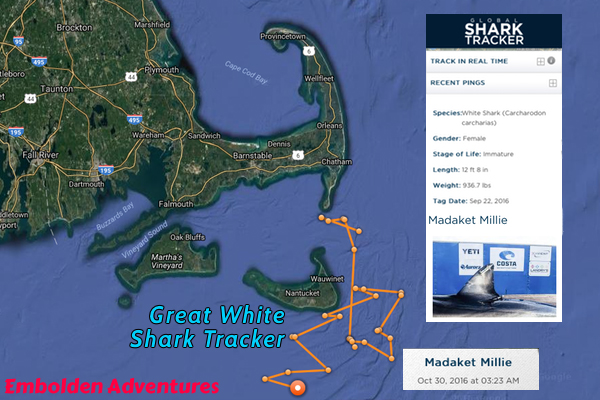
Cape Cod National Seashore
A big highlight in Cape Cod is its unending stretches of pristine beaches that draw many vacationers to its shores each summer.
The Cape has a total of 400 miles of shoreline, and its entire eastern coast faces the Atlantic Ocean.
Cape Cod National Seashore is comprised of 40 miles of beaches and makes up about 20% of the entire 339 square mile landmass of Cape Cod. It is located on the Outer-Cape and north of the Lower-Cape area. This National Seashore was established in 1961 by President John F. Kennedy.
The towns of Truro, Wellfleet, Eastham, and Provincetown are part of the Outer-Cape.
Pine trees, sand dunes, beach grasses, vertical wood slat fences lining the pathway to the ocean’s edge, an occasional lighthouse, and maybe a sailboat or two in the distance make this seashore distinctly New England.
The Highland Lighthouse
In the Cape Cod National Seashore is the famous Highland Lighthouse.
The Highland Lighthouse was the first lighthouse built Cape Cod. It is located is the town of Truro, also known for their vineyards and wine.
In 1797, the Highland Lighthouse was commissioned by George Washington to be built so that ships could navigate safely towards this treacherous part of the coastline. This stretch of water is deceivingly shallower because of submerged, sandy shoals.
Since keeping record, more than 3,000 ships were shipwrecked in this area. Lighthouses such as the Highland Lighthouse provided a reference point to the location of the shore.
American patriot, United States Founding Father, and now Broadway star Alexander Hamilton loved lighthouses and understood how important they were in advancing the budding American economy.
For all of you fans of the Tony award-winning Broadway show Hamilton, the code word is “Rochambeau.” The Hamilton performance of “Yorktown” is about the battle of Yorktown in 1781 during the Revolutionary War, and Rochambeau is mentioned in the song. See where Rochambeau and his troops marched from New England to Yorktown, Virginia here.
And now back to Hamilton. Acting as the First US Treasury Secretary (and the reason why he is on the US$10 bill), Hamilton protected American commerce.
Because many of these shipwrecks lost valuable cargo, Hamilton wanted lighthouses built all along the US eastern seaboard from the northern tip of Maine all the way to the south of Florida.
For many years, lighthouse keepers worked for the US Treasury Department until the effort was taken over by the US Coast Guard in 1910.
The lighthouse keeper and his assistants had this dangerous job. Their main, crucial responsibility was to keep the light burning at all times, especially at night and even more so during inclement weather.
Imagine staying up at night, taking shifts to sleep, making sure that the candles were always burning bright. The candles were housed inside a reflective glass prism that projected the light out to sea.
The candles first burned whale oil, then lard and rapeseed oil. Lard had to be boiled on the ground level and then walked up the spiral staircase to the top of the lighthouse tower. This climb was 69 steps up 5 stories. It was a delicate operation to walk up these narrow stairs with two pails full of hot liquid lard.
Lighthouse keepers even had to scrape away snow and ice accumulating on the outside windows of the lighthouse tower during dangerous winter storms. Keeping that light on was so important for guiding the ships, especially in very bad weather.
When a shipwreck happened, the lighthouse keeper on watch would report the accident to the others down below in the lighthouse barracks. They would communicate by hoisting down a note inside a pail on a string from the tower.
The keepers who retrieved the note would have to race their horse to the rescue ships in Provincetown. The cargo was saved more often than the sailors at sea, unfortunately.
In 1857, the lighthouse installed a reflective Fresnel lens projecting the light more strongly out to sea. This lens contraption was very heavy, and it needed to be rotating. So its foundation was immersed in a vat of liquid mercury for frictionless rotation. The lighthouse keeper had to get in the vat of mercury at times to push the lens. Later, keepers would show signs of mercury poisoning although back then they did not realize mercury was toxic.
By 1932, the candles were replaced with an electrified, 1000 watt beacon, and by 1998, the light bulb switched to an automatic optical light.
My favorite painter Edward Hopper loved to vacation in this Outer-Cape area and painted many of his famous paintings based on his time in Cape Cod. One of his paintings was of this Highland Lighthouse that he completed in 1930.
While in 1797 or in 1930, the lighthouse was much closer to the edge of the ocean cliffs. In 1996, the lighthouse was moved inland to protect it from eroding sea cliffs. Wind, rain, and waves claim 3 feet of cliffs per year. Of the 10 acres set aside for the lighthouse back in 1797, only 4 acres remain due to this erosion.
Go for a visit. Take the guided tour and climb up to the top of the lighthouse using the spiral staircase just like the lighthouse keepers did. Take in the 360-degree ocean views and of the grasslands below. Observe how this delicate forest area of the Cape has now been rejuvenating after getting destroyed through deforestation and land trampling by the early settlers and their herds of livestock.
If you have time, try to get in a round of golf at the golf course on the grounds while you are there.
Provincetown
Beyond the lighthouse to the furthest point of the Outer-Cape is Provincetown.
First reached by settlers in 1602, Provincetown was home to the Pilgrims who arrived in Plymouth Rock on the Mayflower in 1621. The harbor in Provincetown provided the Pilgrims protection from the Atlantic Ocean.
The tall-standing Pilgrim’s Monument, seen from miles away, marks the location of Provincetown. This monument is the tallest granite structure in the United States at 252 feet tall and standing at 350 feet above sea level. Its design is based on Torre del Mangia tower in Siena. In 1907, President Theodore Roosevelt laid the first cornerstone of the monument.
Provincetown can be reached by the ferry from Boston or Plymouth or by car.
Also known as “P-Town”, this quaint, little sea town is a New England summer destination. Year-round its population is 3000 but grows to 60,000 during the height of the summer. Most get around the downtown by foot or by bike.
People come to Provincetown for the clubs, restaurants, art galleries, and ice cream shops. It is a LGBTQ-friendly environment. Stop by to enjoy some traditional New England clam “chowdah” and “lobstah” rolls.
Think about how hard life was back then in Cape Cod as a farmer, fisherman, tradesman, or a revolutionary. Spending time in Cape Cod helped me to understand the difficulty of leaving one’s home and venturing to unknown lands across the Atlantic Ocean for a better life; Or risking your life on a wooden sailboat to trade goods; Or working on little sleep, braving the weather and dangers as a lighthouse keeper. While life along the sea could be harsh at times, the beauty of the area is magnificent as evidenced in these stunning sunsets along the shores.


